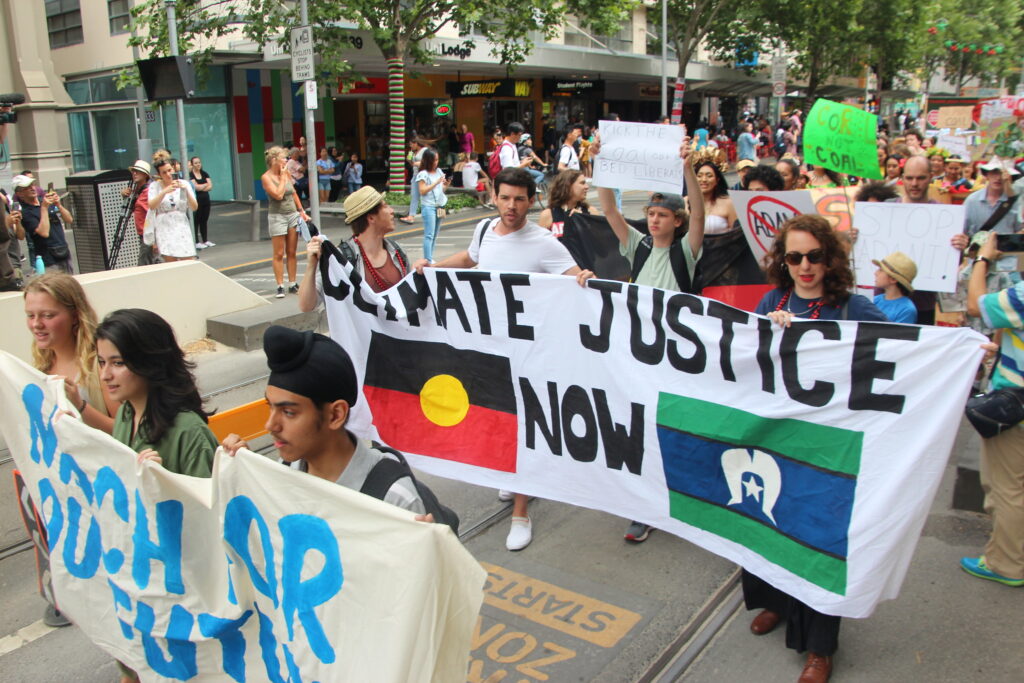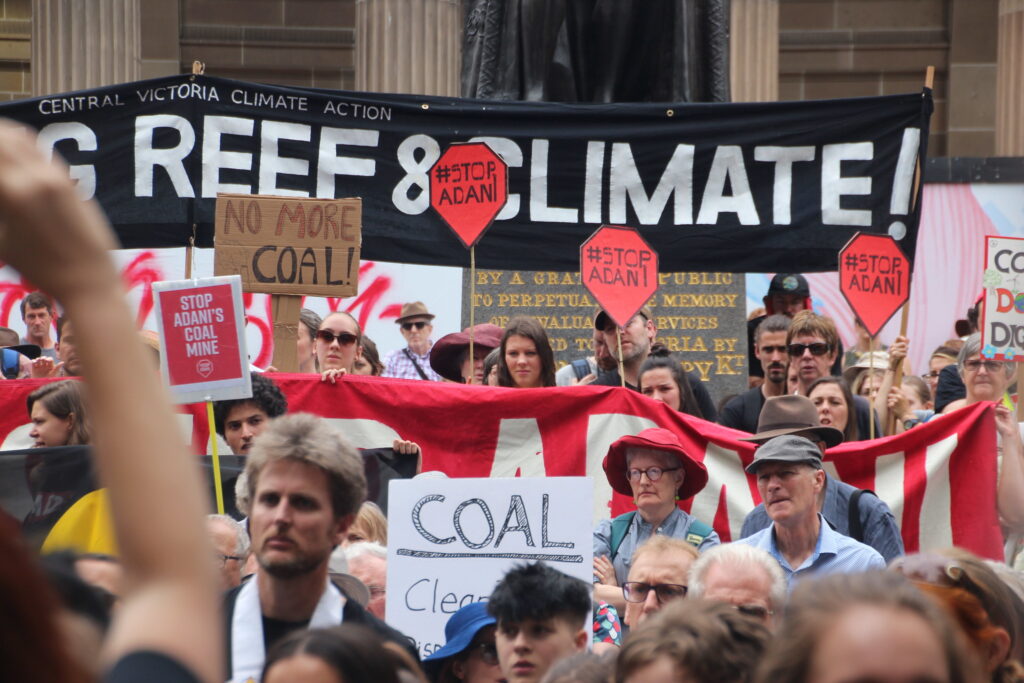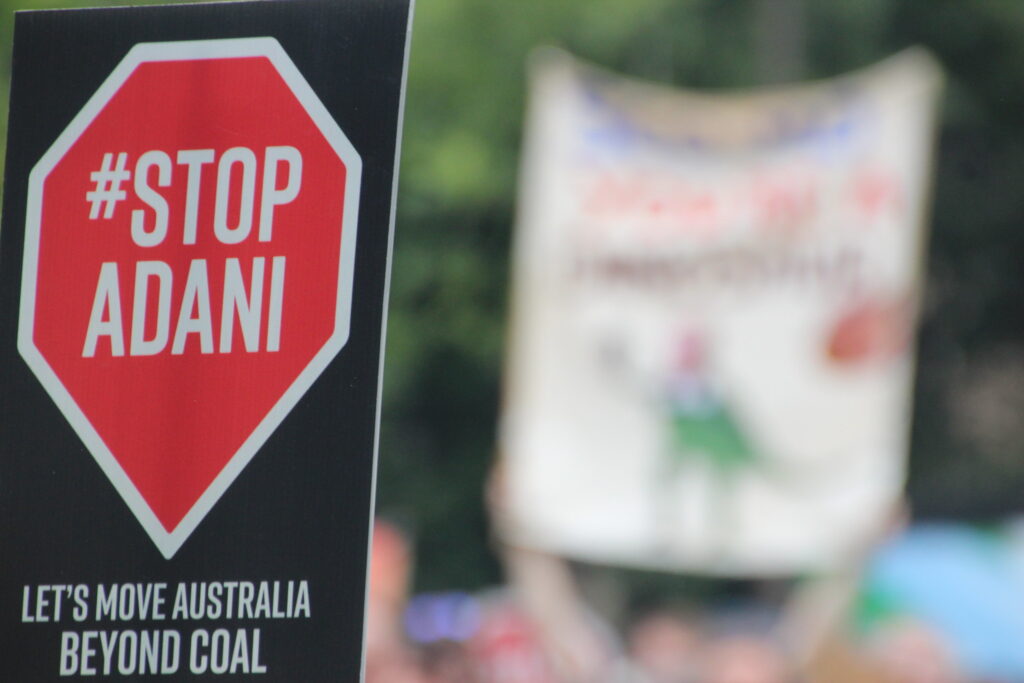Minds of the Movement
An ICNC blog on the people and power of civil resistance
by Robyn Gulliver, Kelly Fielding and Winnifred R. LouisMay 11, 2022
In late 2021, Adani Corporation announced the first coal shipment from the freshly dug Carmichael Coal Mine in central Queensland, Australia. A five-year blockade encampment, the re-occupation of traditional lands on the minesite by Waddananggu Traditional Owners, and relentless fierce civil resistance by hundreds of activist groups seeking to stop the proposed mega-mine appears to have been a failure. But was it?
In our ICNC monograph Civil Resistance against Climate Change, we profiled the campaign responsible for the above-mentioned actions, Stop Adani. At the time we had concluded that it was a successful example of nonviolent resistance, because hundreds of financial institutions and contractors ruled out working on the mine, while the mine's development was substantially delayed and downsized.
The Stop Adani campaign demonstrates the complexity of mapping and measuring success and highlights a number of challenges facing scholars, activists and policymakers seeking to understand civil resistance against climate change. In this post, we identify remaining challenges in this field and offer recommendations on how they might be overcome.

December 2018, Melbourne March for Our future was organized in a little over a week after Adani announced they were proceeding with the Carmichael coal mine. Credit: John Englart/Flickr (CC BY-SA 2.0, unedited).
Challenge #1: The targets and goals of climate change activism are not always clear.
What scholars can do: Embrace consistent movement terminology in their research (references provided below).
What activists can do: Explicitly state the target (a group or individual) of your activism and what you want the target to do.
Climate change is a complex problem requiring multi-level interventions. However, research on civil resistance typically focuses on movements seeking to enact political change by overthrowing repressive regimes or expanding rights and freedoms for marginalized groups.
As a result, little is known about how climate change civil resistance differs from politically focused civil resistance.
This complexity is reflected in the climate change movement. In our research, we found hundreds of autonomous local groups in Australia promoting thousands of events while interacting simultaneously with diverse movement networks and supporting numerous independent and shared campaigns. In our analysis we also found that almost half of civil resistance events did not clearly indicate who the target of the action was or what they wanted the target to do in response. This will be an important step for activists to include in all future actions.
In terms of scholarship, we found that research examining environmental activism demonstrated inconsistent use of terms such as ‘campaign’, ‘movement’ and ‘protest’. Combined with the first point above, detailed analysis of climate change civil resistance proves exceptionally challenging.
One solution for scholars is to support a consistent dictionary of protest related terms. An example is ICNC’s Glossary of Civil Resistance, but also Michael Beer’s addition of 148 new tactics to Gene Sharp’s 198 methods of nonviolent action created in 1973. Many more related resources exist: Nonviolence International lists a comprehensive Tactics Database while Activism Research Hub is developing an extensive list of campaign targets, goals and outcomes for Australian environmental activism.
Larger datasets of activism targets and goals will enhance our ability to identify frameworks which can explain how these movements can grow and more effectively achieve their desired outcomes.

Queensland, Australia experienced record temperatures in 2018 in an extreme heatwave along with catastrophic fire weather. Credit: John Englart/Flickr (CC BY-SA 2.0, unedited).
Challenge #2: Civil resistance success is not absolute.
What activists can do: Make the “success” pie bigger by exploring constructive actions alongside activism.
What scholars can do: Explore the ongoing process of movement outcomes, which includes conducting studies that track effectiveness of civil resistance over time.
The second challenge related to identifying successful or failed climate change civil resistance is the non-linear nature of civil resistance outcomes. As our research demonstrates, most climate change campaigns do not achieve their stated goal. However, this does not mean they are unsuccessful. Instead, multiple sub-wins can occur over the short, medium and long term, before the overarching goal may be achieved.
In our research, we found that numerous organizations had stated an intention to divest in response to activist pressure (initial success). However, only some had acted on their statements to fully divest their financial assets out of fossil fuels (ultimate failure). It will be important to start cataloguing the levers that activists can pull to ensure targets follow through and take action on their commitments.
The theoretical frameworks we applied to our data did not have a mechanism for incorporating the iterative process of movement outcomes (succinctly put, long-term outcomes). Nor were our data or the theoretical frameworks we applied able to fully describe what climate change nonviolent interventions might look like. These are the green alternatives and parallel institutions that we need to construct urgently once our fossil fuel dependency is broken.
To address the challenge of identifying success, first we must gather empirical data linking civil resistance actions to emissions reduction outcomes. Second, we need to better understand how movement networks can work together to achieve incremental success. Organizations such as NetChange are undertaking comparative analysis of new campaign structures to better understand iterative campaign successes, and we look forward to future studies using longitudinal data to track how civil resistance outcomes can ebb and flow over time.

Vigil for Mother Earth - Stop Adani - Melbourne climate march for our future. Credit: John Englart/Flickr (CC BY-SA 2.0, unedited).
Challenge 3: Empirical data do not align with theoretical movement models.
What the policy community can do: Support the development of more datasets on civil resistance against climate change.
What scholars can do: Incorporate the role of digital technology into theoretical frameworks tracking movement outcomes.
The extensive use of online communication in the civil resistance toolkit has enabled unprecedented opportunities to better understand what civil resistance actually looks like. Data can be gathered on how groups promote their events and campaigns online, what they share on their social media pages, and what their civil resistance priorities are through regular e-newsletters to supporters.
However, we found that one of our most significant challenges was attempting to map this data onto the theoretical frameworks we chose in our research. The frameworks did not provide any insights into why one campaign could be seen as both a success and a failure, nor where the most promising avenues for successful civil resistance against climate change may lie in the future.
There are multiple reasons for this challenge. Most movement frameworks were developed well before internet technology enabled the creation of large datasets of civil resistance activity. Furthermore, there is a great diversity of models used to analyze nonviolent movements and little consensus over which frameworks may be more applicable to one particular movement than any other. We have argued elsewhere that the factors that promote some desired outcomes, such as raising awareness or building sympathy, are not necessarily those that promote other desired outcomes such as motivating action or promoting policy change.
There are a number of ways scholars and activists are addressing this challenge. Protest data collected by Harvard’s Kennedy School’s Nonviolent Action Lab and Count Love collect and visualize datasets of protest activity in the United States, which could be analyzed against theoretical frameworks. Researchers and activists could then undertake comparative studies using a variety of frameworks to examine this empirical data and ascertain which framework fits best. This is currently being done drawing on a dataset of environmental justice campaigns (EJAtlas).
***
We hope the future avenues for research and practice identified here will propel faster and more powerful civil resistance demanding urgent action on climate change.

Robyn Gulliver
Dr Robyn Gulliver is a multi-award winning environmentalist, writer and researcher who has served as an organiser and leader of numerous local and national environmental organisations. Her research focuses on the antecedents and consequences of environmental and pro-democracy activism.
Read More
Kelly Fielding
Kelly Fielding is an environmental psychologist at the University of Queensland whose research focuses on developing ways to promoting environmental attitudes and actions. She addresses a range of environmental issues including climate change communication and action.
Read More
Winnifred R. Louis
Winnifred R. Louis (PhD McGill, 2001) is a Professor in Psychology at the University of Queensland. Her research interests focus on the influence of identity and norms on social decision-making.
Read More